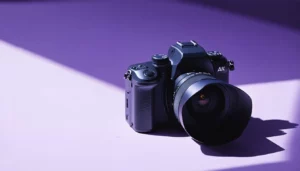Introduction
As an experienced article writer and photography enthusiast, I understand the importance of creating professional photos that capture moments and tell stories. In today’s digital age where anyone can pick up a camera and snap a picture, it’s crucial to stand out from the crowd. Whether you’re a professional photographer looking to improve your skills or a hobbyist aiming to take stunning shots, this article will guide you on how to create professional photos that leave a lasting impression.
Now that we have an outline, let’s delve deeper into each section and uncover the secrets to creating professional photos.
Understanding the Basics
Composition: The art of framing your subject
– The rule of thirds: Placing your subject off-center for a more visually pleasing image.
– Leading lines: Utilizing paths, roads, or other elements to draw the viewer’s eye towards the subject.
– Symmetry and patterns: Exploring the aesthetic appeal of balanced compositions.
– Negative space: Embracing empty areas to emphasize your subject.
Lighting: Harnessing natural and artificial light
– Golden hour: Taking advantage of the soft, warm light during sunrise and sunset.
– Diffused light: Softening harsh shadows by shooting in cloudy conditions or using diffusers.
– Using reflectors: Bouncing light back onto the subject to fill in shadows and create depth.
– Creative use of artificial lighting: Experimenting with studio lights, flash, or even household lamps.
Choosing the Right Equipment
Cameras: From DSLRs to smartphones
– Understanding the features: Exploring different camera options and their advantages.
– Assessing your needs: Deciding whether you require a high-end DSLR or if your smartphone camera will suffice.
– Smartphone photography: Unleashing the potential of your smartphone camera through apps and add-on lenses.
Lenses: The key to capturing the perfect shot
– Prime lenses: Embracing their wide apertures, crisp image quality, and versatile use.
– Zoom lenses: Allowing flexibility in composition and focal length.
– Macro lenses: Exploring the world of close-up photography and capturing intricate details.
Mastering Camera Settings
Aperture: Controlling depth of field
– Understanding f-stops: How different aperture settings affect the background blur and sharpness.
– Shallow depth of field: Creating a dreamy, isolated subject against a blurred background.
– Deep depth of field: Keeping everything in focus for landscapes or group photos.
Shutter Speed: Freezing or blurring motion
– Fast shutter speed: Capturing action shots with sharp details.
– Slow shutter speed: Creating mesmerizing long-exposure images or adding motion blur.
– Panning technique: Tracking a moving subject while keeping it sharp against a blurred background.
ISO: Balancing light sensitivity and noise
– Low ISO: Preserving image quality and reducing noise in well-lit situations.
– High ISO: Compensating for low light conditions but being mindful of increased noise.
Preparing for the Shoot
Location scouting: Finding the perfect backdrop
– Researching potential locations: Looking for interesting landscapes or suitable indoor settings.
– Checking the lighting conditions: Ensuring the right atmosphere for your photo shoot.
– Legal considerations: Understanding permits and restrictions when shooting in public spaces.
Planning your shots: Visualizing your ideas
– Storytelling through images: Creating a concept or narrative for your shoot.
– Storyboarding: Sketching out your vision and planning angles or poses.
– Gathering inspiration: Exploring the works of other photographers or art forms.
Directing the Subject
Posing: Making your subject look their best
– Guiding your subject: Providing clear instructions and making them feel comfortable.
– Natural poses: Encouraging movement and capturing genuine emotions.
– Expressions and body language: Understanding how they reflect mood and personality.
Communicating: Building rapport and putting them at ease
– Making connections: Engaging in conversation and getting to know your subject.
– Small talk: Taking the focus off the camera and creating a relaxed atmosphere.
– Providing feedback: Offering positive reinforcement and constructive criticism.
Nailing the Editing Process
Software: Exploring different editing tools
– Adobe Lightroom: Utilizing its wide range of editing features, including exposure adjustments, color grading, and retouching.
– Adobe Photoshop: Leveraging advanced tools for meticulous retouching and compositing.
– Other editing software options: Exploring free or more beginner-friendly alternatives.
Workflow: Enhancing images while maintaining realism
– Organizing your files: Staying organized to easily locate and work on your photos.
– Non-destructive editing: Preserving the original file and being able to revisit previous adjustments.
– Striking a balance: Enhancing your images without overdoing it and losing the natural feel.
Showcasing Your Work
Print: Creating photo albums and portfolios
– Printing options: Exploring professional printing services or at-home prints.
– Photo albums: Assembling a collection of your best work in a physical format.
– Portfolios: Creating digital or online portfolios to share with potential clients or employers.
Online platforms: Sharing your photos with the world
– Social media: Utilizing platforms like Instagram, Facebook, or Flickr to gain exposure and connect with others.
– Building a website: Showcasing your portfolio and attracting clients through a personal website.
– Engaging with the photography community: Participating in online forums, contests, or collaborative projects.
Conclusion
Creating professional photos is not just about technical skills; it’s an art that requires creativity, vision, and the ability to connect with your subject. By understanding the basics, choosing the right equipment, mastering camera settings, preparing for each shoot, directing your subjects, nailing the editing process, and showcasing your work effectively, you can elevate your photography to a professional level.
FAQs
Is it necessary to invest in expensive photography equipment to create professional photos?
Not necessarily. While high-end equipment can offer more features and better image quality, it’s possible to create professional-looking photos with smartphones or entry-level cameras by mastering the fundamentals.
What software should I use for editing?
Adobe Lightroom and Photoshop are popular choices among professional photographers. However, there are also other free or more beginner-friendly editing software options available, depending on your specific needs and budget.
How can I improve my composition skills?
Practice, practice, practice! Experiment with different composition techniques and study the works of renowned photographers to gain inspiration and insights. Continuous learning and experimentation can help refine your composition skills over time.
What’s the best way to showcase my work online?
Social media platforms like Instagram, Facebook, or Flickr provide excellent opportunities to share your photos and engage with a wider audience. Additionally, building a personal website with an online portfolio can help attract potential clients or employers.
How important is the editing process in creating professional photos?
Editing plays a crucial role in enhancing your images and bringing out their full potential. However, it’s essential to maintain a balance and not overdo it. The goal is to enhance your images while preserving their natural feel.






